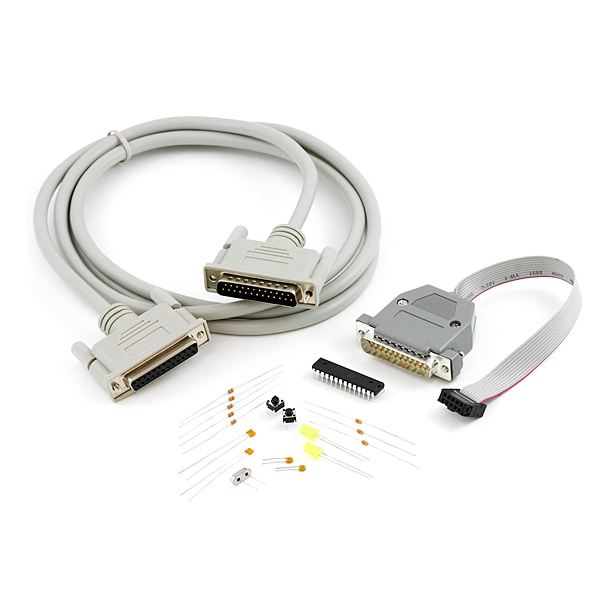Beginning Embedded Electronics - Microcontroller Kit
This is a large mass of items that go along with the Beginning Embedded Electronics lectures. The ATmega328 is now included in this kit. This new pin-compatible Atmel microcontroller has substantially more flash memory than the ATmega8.
This kit will includes the following parts.
Note: You will need a parallel port to use this kit. If you have a laptop, chances are you don't have a parallel port. If you don't, you might want to get the Pocket Programmer listed below which will allow you to use this kit without a parallel port.
ATmega8 Lecture:
Beginning Embedded Electronics - Microcontroller Kit Product Help and Resources
Core Skill: Programming
If a board needs code or communicates somehow, you're going to need to know how to program or interface with it. The programming skill is all about communication and code.
Skill Level: Rookie - You will need a better fundamental understand of what code is, and how it works. You will be using beginner-level software and development tools like Arduino. You will be dealing directly with code, but numerous examples and libraries are available. Sensors or shields will communicate with serial or TTL.
See all skill levels
Core Skill: Electrical Prototyping
If it requires power, you need to know how much, what all the pins do, and how to hook it up. You may need to reference datasheets, schematics, and know the ins and outs of electronics.
Skill Level: Rookie - You may be required to know a bit more about the component, such as orientation, or how to hook it up, in addition to power requirements. You will need to understand polarized components.
See all skill levels
Comments
Looking for answers to technical questions?
We welcome your comments and suggestions below. However, if you are looking for solutions to technical questions please see our Technical Assistance page.
Customer Reviews
No reviews yet.


I completed Lecture 2, Microcontroller Kit, using the Atmega168 in about 75 minutes. Everything went well. I had trouble getting the "blink" program to download to the chip, but after discovering that I had one of the Vcc wires in the wrong slot, the download succeeded and the LED blinks. These are very instructive tutorials, and fun, too.
can i use a USB to parallel adapter like this one to use this with my laptop http://www.amazon.ca/Cables-16899-IEEE-1284-Parallel-Printer/dp/B000UX21PY/ref=sr_1_1?ie=UTF8&qid=1399264985&sr=8-1&keywords=usb+to+parallel+adapter
thanks
this is tough question. I can't answer it directly, but generally speaking, USB to parallel devices aren't always reliable. It might work for a printer, but I'm not confident it will work for programming.
NEED this in stock! PLEASE!!!
This is a wonderful tutorial, and has definitely helped me to start getting into embedded electronics. I was unable to buy the components from SparkFun, however, as I live in the UK. If anyone else is looking for a nice, cheap place to pickup components from, you can check out http://uk.rs-online.com/web/. They had most of what I was looking for, and anything they didn't have (which was only an SPDT switch, so far), I just picked up from my local Maplins. The only downside to rs-online is that you have to buy certain things in packs of 5 or 10, however they still tend to be quite cheaper than most other places, and get even cheaper if you buy in bulk. As a side note, I've noticed that the checkout procedure only seems to work with Internet Explorer ?_?
Perhaps you could have a version of this kit with the serial programmer for those of us that don't have parallel ports.
Or, you could use the "add to cart" button that adds the individual components so that I can adjust the cart to replace the parallel programmer with the serial one.
Thanks!
The kit is designed specifically for the tutorial. It is boxed up separately for that purpose. We sell all the items individually however.
I only have USB ports as I am exclusively using my laptop. I guess I am going to buy the USBtinyISP AVR Programmer but I need help re-creating the items list for this kit so that I end up with the precisely correct components (minus the port programmer and extension cable, of course.) My problem is that the exact individual sku's are not provided on the product page for the kit and, unlike other kits, this one is invoiced as a single item, making al la cart picks impossible for a dumb newbie like me. Please help!
Ok, each part is a link. So you can add each one individually if you want. Hopefully that helps!
You should give the option to buy the ATmega328 instead of the ATmega168, which has been out of stock for some months now...
When I first saw this kit I was searching for some easy way to start with this kind of things and I hadn't any idea of what could replace what.
While I don't need this kit, I really like the way you're dealing with the kit in the ordering system. It makes such perfect sense to have it orderable as a single item, while being able to add and remove individual components as required. Very nice.
I understand that this kit covers lectures 1-3 but why are there these extra parts? 2 extra 330 Ohm and 4 extra 10k Ohm resistors and an extra push button?
I get that the led is for breaking ;)